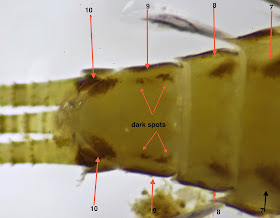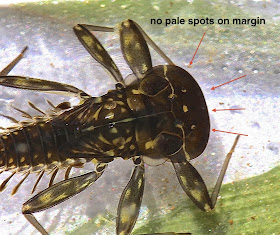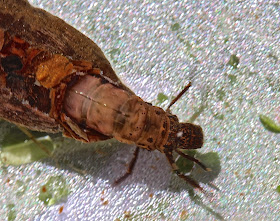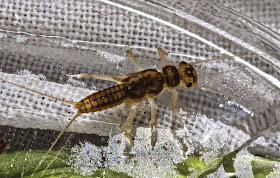(Note: This is a follow-up to the entry posted on 5/9/14.)
In 1982, Unzicker and Carlson published a key to Leucrocuta species ID ("Ephemeroptera," pp. 3.72-3.73 in Brigham, Brigham, and Gnilka, Aquatic Insects and Oligochaetes of North and South Carolina). Yesterday I decided to see what I could make of the nymphs that I've found using that key. However, before I proceed with my results, let me note at the outset that there's a problem. According to Beaty, entomologists are now hesitant to rely fully on that 1982 work: some of the characters used to make the ID's overlap from species to species. A new key is being prepared. Let's hope that addresses the shortcomings of this earlier key.
That being said, the five species that are ID'd in the 1982 key are the same five listed by Beaty as those that are likely to be found in our streams: aphrodite, hebe, juno, maculipennis, and thetis. So let's proceed with the key having noted that there might be problems.
Using that 1982 key, I think I can safely ID three of the four nymphs -- or types of nymphs -- that I've found. They are L. hebe, L. aphrodite, and L. thetis. The fourth nymph -- the one in the photo at the top of the page -- is likely to be L. juno, but there's not much to go on in the key that we have.
1. Leucrocuta hebe
Here are some of the key features to see: "tracheae of gills distinct; pale markings on dorsum of abdominal segments 7 and 8 coalesce to form a large pale blotch; head with 3 pale spots on each side of frontal margin; a row of dark streaks present laterally on each side of venter of abdomen." Also "V-shaped pale median triangle present on dorsum of abdominal segment 9 and covering most of middle of segment, its apex extending almost to posterior margin." Let's have a look.
We can see all three of the pale spots at the front of the head, but only on the one side. Also, note that the large pale spots on segment 7 don't exactly "coalesce," but close enough. I'd say segment 9 matches the description. Venter?
Yes. There are dark lateral streaks on all of the segments. Our key also says: "dark area present at each posterolateral angle of venter of abdominal segment 9, sometimes smaller dark area also present at each anterolateral angle of segment 9, but the dark areas are not connected to form a continuous dark margin." Not exactly what we see with the spots on segment 9, but there clearly are two spots on 9, and they are not connected.
I'd say these nymphs are Leucrocuta hebe.
I should add that Knopp and Cormier would also ID these nymphs as L. hebe (Mayflies, p.152), and our photos agree with the L. hebe photo posted by Donald Chandler (http://www.discoverlife.org/mp/20q?search=Leucrocuta+hebe).
___________________
2. Leucrocuta aphrodite
Segments 7, 8, and 9 on L. aphrodite are the same as we find on L. hebe (pale areas on 7 and 8 coalesced: pale area on 9, V-shaped, with apex close to hind margin). We can see that in the following photo. We can also see the 3 pale spots on the edge of the head.
However, the "U-shaped" pale areas on segments 4 and 5 on L. hebe are not found on L. aphrodite, and on L. aphrodite, the "dark areas on [the] femora [are] usually more extensive than [the] dark areas."
The reverse is true on L. hebe. (Visible in the photos above.)
Beaty notes that "most Leucrocuta in the Piedmont are probably aphrodite" ("The Ephemeroptera of North Carolina," p. 19). Most Leucrocutas I find are L. aphrodite as well. (Buck Mt. Creek, Doyles River, etc.)
________________
3. Leucrocuta thetis
L. thetis is described in the following way: "Tracheae of gills indistinct; pale markings on dorsum of abdominal segments 7 and 8 not coalesced; head without pale spots along frontal margin; lateral dark streaks present only on venter of abdominal segment 9." For the lack of tracheation in gills --
I would agree. And here's a good look at the head.
On my nymph, there are two pale dots on segment 8, very little on segment 7.
________________
4. Leucrocuta juno?
This nymph is very distinctive and differs markedly from the other nymphs we have seen. Note the appearance of the abdominal segments, and the dark color of the femora with just a few pale spots. However, the description that our key provides is woefully wanting. 1) "Posterior margin of dorsum of abdominal segment 9 brown with anterior part of segment mostly pale; pale V-shaped area absent." True.
"Gills heavily shaded with purplish-black, with paler areas at extreme tip, on inner median space next to main trachea, and near base of outer margin; dark markings at anterior of sternites 8 and 9, in median area." The gills are heavily shaded, with pale areas at the tips and in the inner median space.
That's very good. But, the gills on L. thetis look exactly the same! (Look at the photo above.) Unfortunately, I can't see "dark markings at [the] anterior of sternites 8 and 9 on my nymph."
While that might make this nymph L. maculipennis (see p. 3.75), our nymph lacks other critical features of maculipennis (e.g. "pronotum widest at anterior margin"). And, our photo matches the L. juno that Donald Chandler has posted (http://www.discoverlife.org/mp/20q?search=Leucrocuta+juno). Were it not for that fact, I'm not sure I'd venture the guess that this is Leucrocuta juno.
_____________________________________
That's the best I can do at the moment. And Beaty is right, the 1982 key is in need of revision. Still, I think there's a pretty good chance that we can safely ID three of the nymphs that I've found: possibly all four. Time will tell.
Oh. One other thing. I've only seen L. thetis and L. juno -- if I'm right about those ID's -- in small mountain streams in Sugar Hollow. I suspect they're uncommon.



































































